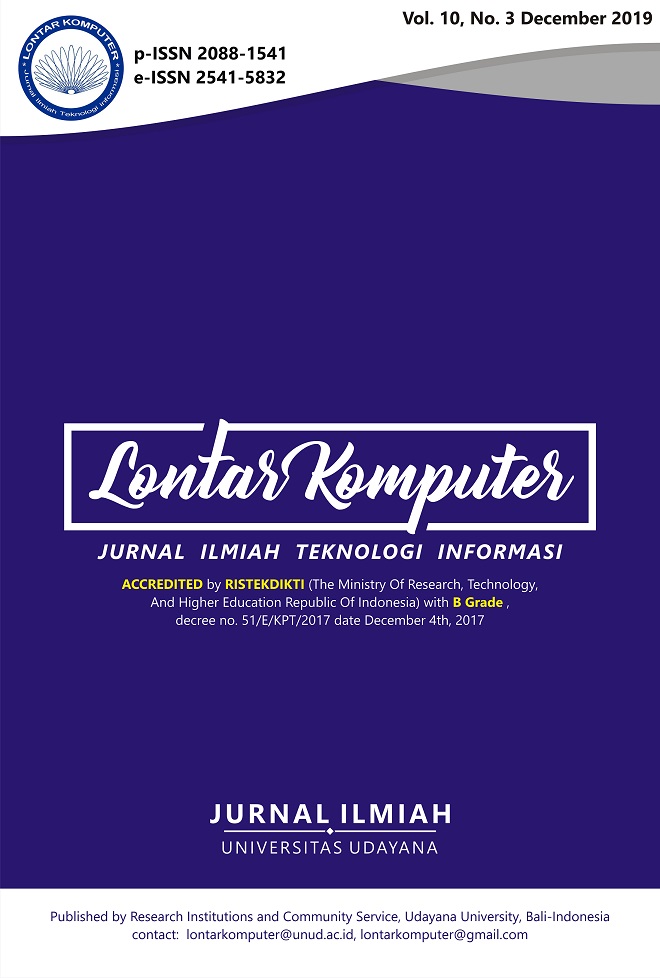Data Transmission Method on a Room Condition Telemonitoring Application (IoT)
Abstract
Data transmission system in IoT applications such as telemonitoring, using cable or wireless, requires a robust data transmission method. In this paper, a room condition telemonitoring application has been made where all data are read from raspberry pi, and sent to a pc server every minute using LAN and Wifi media, then update to a webserver. The data are sent using the method proposed in this paper which using the UDP mechanism with several improvements. Experiments have been done using LAN and Wifi, and it is found that the data can be received perfectly, although there are interferences from communication media. The average processing time on a raspberry pi is 19 ms, while the average processing time on the pc server is 5 us. In addition, the average processing speed of the transmission data from raspberry pi to a pc server until ack is received by raspberry pi using LAN media is 0.04 second, while using Wifi media is 0.08 seconds. Based on the experiments, it was found that the proposed method was successfully implemented in the room condition telemonitoring.
Downloads
References
[2] N. Bouchemal, R. Maamri and N. Bouchemal, “Mobile Agent System Based Cloud Computing for Ubiquitous Telemonitoring Healthcare,” in International Conference on Mobile, Secure, and Programmable Networking, Paris, 2018, vol. 4, pp. 107-116.
[3] T. H. Y. Ling and L. J. Wong, “Elderly infrared body temperature telemonitoring system with XBee wireless protocol,” in International Conference MSPN 2018, Paris, 2018, vol. 22, pp. 103–120.
[4] M. Mirdanies, “Optimization of Robot Telemonitoring System Software using multi-thread method” Journal of Informatics, Control Systems, and Computers (INKOM Journal), vol. 11, no. 1, p. 15–24, 2018.
[5] M. Elhoseny, G. Ramírez-González, O. M. Abu-Elnasr, S. A. Shawkat, A. N and A. Farouk, “Secure Medical Data Transmission Model for IoT-Based Healthcare Systems,” IEEE Access, vol. 6, pp. 20596–20608, 2018.
[6] C. P. Kumar and R. Selvakumar, “Erasure Codes for Reliable Communication in Internet of Things (IoT) Embedded with Wireless Sensors,” in Lecture Notes on Data Engineering and Communications Technologies book series (LNDECT, volume 14), Cham: Springer, 2017, pp. 115–137.
[7] H. C. Hwang and J. G. Shon, “Design and Implementation of a Reliable Message Transmission System Based on MQTT Protocol in IoT,” Wireless Personal Communications, vol. 91, no. 4, pp. 1765–1777, 2016.
[8] M. Mirdanies, H. M. Saputra and E. Rijanto, “Algorithm of 32-bit Data Transmission Among Microcontrollers Through an 8-bit Port,” Journal of Mechatronics, Electrical Power, and Vehicular Technology, vol. 6, no. 2, p. 75-82, 2015.
[9] N. Cameron, “Sensors,” in Arduino Applied, Berkeley, CA: Apress, 2019, pp. 31–78.
[10] A. Rayes and S. Salam, “The Internet in IoT,” in Internet of Things From Hype to Reality, Cham: Springer, 2019, pp. 37–65.
[11] I. Alsmadi, R. Burdwell, A. Aleroud, A. Wahbeh, M. Al-Qudah and A. Al-Omari, “Encryption and Information Protection/Integrity and Concealment Methods: Lesson Plans,” in Practical Information Security, Cham: Springer, 2018, pp. 91–120.
[12] S. Jiang, “Error Control,” in Wireless Networking Principles: From Terrestrial to Underwater Acoustic, Singapore: Springer Singapore, 2018, pp. 35–50.
[13] P. Ivaniš and D. Drajić, “Cyclic Codes,” in Information Theory and Coding - Solved Problems, Cham: Springer, 2017, pp. 237–325.
[14] B. Group, “CRC Mathematics and Theory | Embedded Systems Experts.” [Online]. Available: http://www.barrgroup.com/Embedded-Systems/How-To/CRC-Math-Theory. [Accessed: 19-Aug-2019].
[15] M. Olsson and M. Olsson, “Strings and Numbers,” in Modern C Quick Syntax Reference, Berkeley: Apress, 2019, pp. 109–112.
[16] K. C. Wang and K. C. Wang, “Timers and Time Service,” in Systems Programming in Unix/Linux, Cham: Springer, 2018, pp. 187–204.
The Authors submitting a manuscript do so on the understanding that if accepted for publication, the copyright of the article shall be assigned to Jurnal Lontar Komputer as the publisher of the journal. Copyright encompasses exclusive rights to reproduce and deliver the article in all forms and media, as well as translations. The reproduction of any part of this journal (printed or online) will be allowed only with written permission from Jurnal Lontar Komputer. The Editorial Board of Jurnal Lontar Komputer makes every effort to ensure that no wrong or misleading data, opinions, or statements be published in the journal.
 This work is licensed under a Creative Commons Attribution 4.0 International License.
This work is licensed under a Creative Commons Attribution 4.0 International License.























